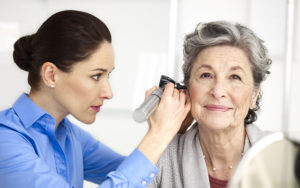We recommend a full clinical hearing test and consultation at our clinic when screening results or symptoms suggest hearing issues. Additionally, clients referred by a GP or Ear, Nose & Throat Specialists, Workers Compensation, and Office of Hearing Services clients are also provided a full assessment.
Otoscopic inspection
This simply involves looking into the ear canal to check the condition of the ear canal and eardrum.
This inspection can provide a lot of information about what’s happening within the middle ear. It also identifies if there are any visible problems that may influence the results of hearing tests, such as a perforation in the tympanic membrane or compacted build up of cerumen (ear wax).
Pure tone audiometry
Air conduction tests
 The simplest way to test hearing is called pure tone audiometry. This involves sitting in a soundproof booth (see photo) and being played a series of beeps and whistles, called pure tones, through headphones or earphones and indicating when you can hear them, generally by pressing a button.
The simplest way to test hearing is called pure tone audiometry. This involves sitting in a soundproof booth (see photo) and being played a series of beeps and whistles, called pure tones, through headphones or earphones and indicating when you can hear them, generally by pressing a button.
When your hearing is measured with pure tones presented through headphones, this measurement is called air conduction. The sounds go via the air, down the ear canal, through the middle ear, and to the very delicate organ of hearing in the inner ear, the cochlea.
The loudness of each tone is reduced until you can just hear the tone. The softest sounds you can hear are known as your hearing thresholds, and these are marked on a graph called an audiogram (to learn how to interpret an audiogram, click here).
The purpose of the test is to find the quietest sounds that you can hear at the full range of frequencies common to human speech, usually 250 Hz to 8000 Hz.
The quietest sounds you can hear, known as hearing thresholds, will be marked on a graph called an audiogram.
This information will determine the degree and type of hearing loss you may have. Hearing loss is measured in decibels (dB), which measure intensity, and pitch in hertz (Hz), which measures frequency. Hearing loss is usually described as normal hearing, mild hearing loss, moderate hearing loss, moderately-severe hearing loss, severe hearing loss, or profound hearing loss.
Bone conduction tests
The sensitivity of the cochlea can also be tested by placing a small vibrator on the mastoid bone behind the ear and, once again, measuring the softest sounds that can be heard. Sounds presented this way travel through the bones of the skull to the cochlea and hearing nerves, bypassing the middle ear.
This type of testing is called bone conduction. The air conduction and bone conduction hearing levels on the audiogram can tell us a lot about where the hearing problem is being caused.
For example, if bone conduction tests indicate less hearing loss than a test through headphones, results would indicate that at least part of the hearing loss could be attributed to conductive hearing loss. Reasons could include fluid in the middle ear, excessive wax, a perforated tympanic membrane, or that the bones of the middle ear are not functioning normally.
Speech Tests
The ability to hear speech is a function of the ability to detect and understand the sounds of speech. The range of audible sounds, not just the degree of hearing loss, varies considerably from person to person. Unfortunately, when hearing is damaged it is usually not just the volume of sound heard that is lost; often the quality of the sound is also distorted.
Speech tests are used to determine how clearly someone can understand speech when visible cues such as lip-reading are removed. They usually involve using common lists of words played (or spoken) at a constant volume that are appropriate to the client’s hearing loss.
The client responds by guessing the word that was spoken, and correct and incorrect answers are tallied.
Speech-in-Noise Tests
Given that people with hearing loss commonly have the greatest difficulty understanding speech in the presence of background noise; it makes sense that speech discrimination tests are also performed with the addition of a “noise” stimulus. This is often a ‘speech babble’ played at different volumes relative to the speech volume (words or phrases). The client responds by guessing the word or phrase that was spoken in the presence of background noise, and results are tallied.
Aided Vs Unaided Tests
Following the fitting of a hearing device, an audiologist will run the tests again to compare how their client is able to perform in the speech discrimination tests with the benefit of a hearing aid compared to when they are not wearing a hearing aid.
Tympanograms and Reflex Tests
Tympanograms measure the movement and flexibility of the tympanic membrane to identify whether it is moving normally.
Results may indicate a problem in the middle ear that can cause a conductive hearing loss. When a child has a normal tympanogram, it may also be possible to test for the presence of a muscle reflex (i.e. acoustic reflex) in the middle ear. The absence of this reflex to different sounds gives information about the functioning of the auditory system.
Make an appointment
You can call us to make an appointment for a FREE Hearing Aid Discussion & Screen on 02 9999-6314 or click here to use our online Make an Appointment form.
